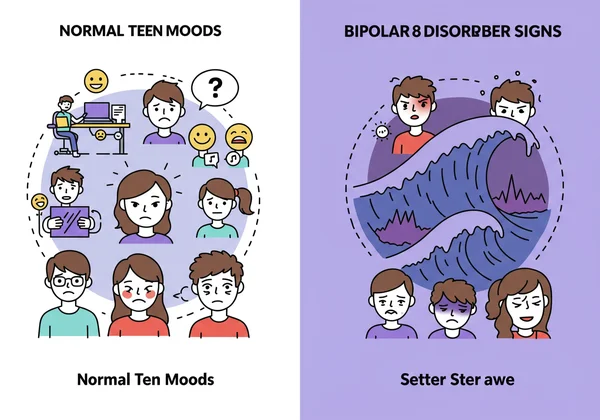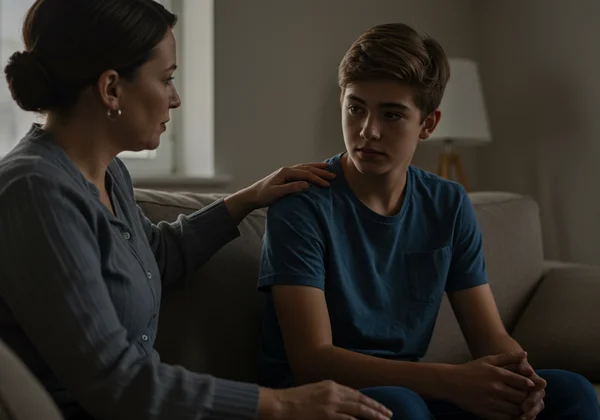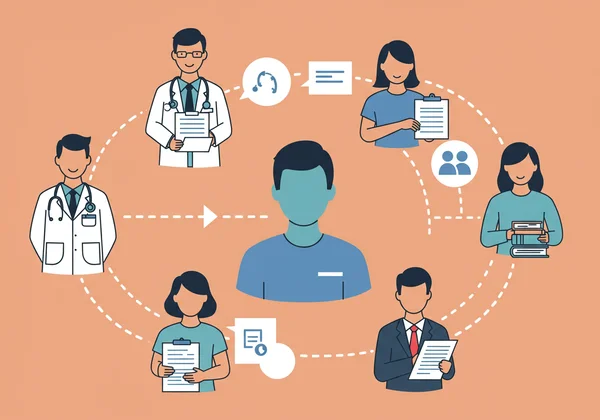Bipolar Disorder Test for Teens: Understanding Signs, Symptoms, & Diagnosis
Adolescence can feel like an emotional rollercoaster, making it difficult to discern typical moodiness from something more serious. If you're a parent or a teen grappling with extreme highs and lows, this guide offers clarity on bipolar disorder signs and what to do next. If you're wondering where to begin, a confidential Bipolar Disorder Test can be an invaluable starting point. But how to test for bipolar disorder? It starts with information and awareness.
The journey to understanding can feel overwhelming, but you're not alone. An initial step can be a simple, private self-assessment. A confidential bipolar disorder screening test can provide preliminary insights into mood patterns in a safe, judgment-free environment.

Teenage Bipolar Symptoms: More Than Just Mood Swings
It's one of the most challenging distinctions for parents to make: is it hormones, or is it a potential mental health condition? While most teens experience mood swings, the emotional shifts associated with bipolar disorder are typically more extreme, persistent, and disruptive to daily life. They aren't just bad moods; they are distinct episodes of mania or hypomania and depression.
Differentiating Normal Teen Moods from Bipolar Signs
Understanding the difference between typical adolescent behavior and potential bipolar symptoms is critical. Normal teen mood swings are often triggered by specific events—a fight with a friend, a bad grade, or social stress—and usually pass relatively quickly. In contrast, the mood episodes in bipolar disorder have a life of their own. They can last for days or weeks, significantly impact sleep and energy levels, and cause a noticeable shift from the teen's usual personality, often disrupting school, relationships, and home life. Look for these cyclical patterns rather than isolated incidents of moodiness.

Key Indicators of Mania and Hypomania in Adolescents
The "highs" of bipolar disorder are known as mania or a less severe form called hypomania. In teenagers, these episodes don't always look like euphoric happiness. They can often manifest as extreme irritability, agitation, or aggression. Key signs include a noticeably elevated mood or explosive temper, a decreased need for sleep without feeling tired, and racing thoughts that make it hard to focus. You might also observe unusually impulsive behavior, such as reckless driving, spending sprees, or risky sexual activity. This isn't just being energetic; it's a significant and sustained departure from their baseline behavior.
Depressive Episodes in Young People: What to Look For
The depressive phase of bipolar disorder can be easily mistaken for unipolar depression. A teen may experience persistent sadness, a profound loss of interest in activities they once enjoyed, and overwhelming feelings of worthlessness or guilt. Other signs include significant changes in appetite or weight, sleeping far more than usual, and physical complaints like headaches or stomachaches. A key feature of bipolar depression is the profound lack of energy and motivation, which can lead to severe social isolation and a drop in academic performance. It’s more than just feeling down; it’s a heavy, oppressive state that can feel impossible to escape.
Navigating Adolescent Bipolar Disorder: A Guide for Parents
If you recognize some of these signs in your teenager, your support and approach are crucial. Navigating this path requires patience, empathy, and a proactive mindset. Your role is not to diagnose, but to create a safe environment where your teen feels comfortable enough to get the help they need. The first step can be learning more with an online bipolar disorder test.
How to Approach a Conversation with Your Teen
Starting a conversation about mental health can be daunting. Choose a calm, private moment when you won't be interrupted. Approach the topic with love and concern, not accusation. Use "I" statements to express what you've observed, such as, "I've noticed you seem to have very little energy lately, and I'm worried about you." Focus on their feelings and experiences. The goal is to foster open communication and let them know you are there to support them, no matter what.
Setting Boundaries and Providing Support
Living with a teen who may have bipolar disorder can be chaotic. While providing unwavering emotional support is vital, it's equally important to maintain a structured and predictable environment. Establishing a consistent routine for sleep, meals, and daily activities can have a stabilizing effect on mood. It's also essential to set healthy boundaries around behavior. This isn't about punishment; it's about creating a safe and stable home life for everyone, including siblings and yourself. This balance reinforces that while their feelings are valid, certain behaviors have consequences.

When to Seek Professional Help for Your Teen
Online screening tools and your own observations are important preliminary steps, but they are not a substitute for a professional diagnosis. If your teen's symptoms are persistent, severe, and interfering with their ability to function at school or home, it is time to seek help. If they talk about self-harm or suicide, seek immediate emergency assistance. A child psychiatrist or a licensed therapist specializing in adolescent mood disorders can conduct a thorough evaluation and provide an accurate diagnosis, which is the first step toward an effective treatment plan.
Understanding the Bipolar Disorder Test for Teenagers & Next Steps
Taking that first step toward understanding can feel empowering. Whether you're a teen trying to make sense of your feelings or a parent seeking clarity, knowing the available resources is key. A bipolar disorder test for teenagers isn't a single, definitive exam but a process that starts with awareness and ends with professional insight.
The Role of Online Screening Tools for Teens
In today's digital world, an online screening tool can be a powerful and accessible first resource. Our free online bipolar disorder test offers a fast and confidential way to assess symptoms based on established psychiatric screening questionnaires. This kind of bipolar screening questionnaire helps identify patterns of behavior and mood that may indicate a need for further evaluation. It’s not a diagnosis, but it provides valuable, structured information that can make starting a conversation with a doctor feel much more manageable.
What a Professional Psychiatric Assessment Entails for Adolescents
A formal diagnosis can only be made by a qualified mental health professional. A comprehensie evaluation for a teenager typically involves several steps. The clinician will conduct detailed interviews with both the teen and their parents to get a full picture of the symptoms, their duration, and their impact. They will gather a complete medical and family history, as mood disorders often have a genetic component. They will also work to rule out other conditions that can mimic bipolar disorder, such as ADHD, anxiety disorders, or the effects of substance use, to ensure the diagnostic process is accurate.

Building a Support Team: Therapists, Doctors, and School Resources
Managing bipolar disorder is a team effort. An effective treatment plan often involves a combination of medication (prescribed by a psychiatrist) and therapy (with a psychologist or licensed therapist). Cognitive Behavioral Therapy (CBT) can be particularly helpful for teens in learning to manage their thoughts and behaviors. It's also vital to build a wider support network. This includes keeping the pediatrician informed and looping in trusted staff at your teen's school, such as a school counselor or psychologist, who can provide academic accommodations and a safe space during the school day.
Taking Action: Supporting Teens and Families
Early recognition of bipolar disorder in a teenager is a powerful step towards their well-being. It helps turn confusion into understanding, fear into proactive steps, and isolation into connection. This journey requires courage from teens and unwavering support from their families. Remember, bipolar disorder is a treatable medical condition, not a personal failing. With the right diagnosis, a tailored treatment plan, and a strong support system, teenagers can learn to manage their symptoms effectively and lead fulfilling lives.
If you're ready to take the next step toward understanding, begin with a confidential assessment. Take our free bipolar disorder test on our homepage today to gain valuable insight and find guidance for your journey.
Frequently Asked Questions About Bipolar Disorder in Teenagers
How can parents tell if their teenager has bipolar disorder?
Parents should look for distinct, prolonged episodes of mood changes that are a significant departure from their teen's usual self. This includes periods of extreme irritability or elevated mood (mania/hypomania) alternating with periods of deep sadness and low energy (depression). Key indicators are severe changes in sleep patterns, energy levels, and behavior that disrupt school, friendships, and family life.
What is commonly mistaken for bipolar disorder in teens?
Several conditions can overlap with or be mistaken for bipolar disorder in adolescents. These include Attention-Deficit/Hyperactivity Disorder (ADHD, which shares symptoms like impulsivity and irritability; major depressive disorder, which lacks the manic or hypomanic episodes; anxiety disorders; and borderline personality disorder. A thorough professional evaluation is essential to distinguish between these conditions.
How do teenagers get tested for bipolar disorder?
There is no single blood test or brain scan for bipolar disorder. The diagnostic process begins with recognizing symptoms. An excellent starting point is using a confidential online bipolar screening tool to organize your observations. Following that, a comprehensive psychiatric assessment by a mental health professional is required. This involves detailed interviews with the teen and parents, a review of symptoms, and ruling out other medical or psychiatric conditions.
Is there a specific 'bipolar disorder test' designed for teenagers?
While the core diagnostic criteria are similar for teens and adults, clinicians use assessment tools and interview techniques tailored to adolescents. Screening questionnaires, like the Mood Disorder Questionnaire (MDQ) that inspires many online tests, are adapted to capture how symptoms present in a younger population. The most important "test" is a comprehensive evaluation by a professional experienced in working with teens.